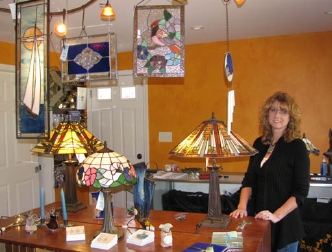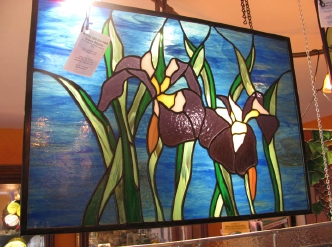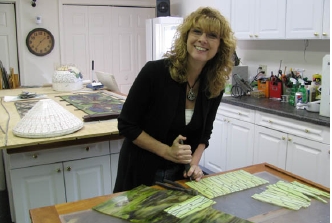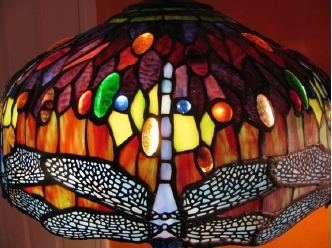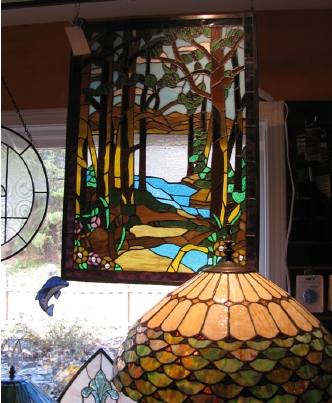
|
|
|
|
|
|
|
|
|
|
|
|
|
|
|
Feature Stories:
Exotic Perennial Garden
beautifies Dublin Residence
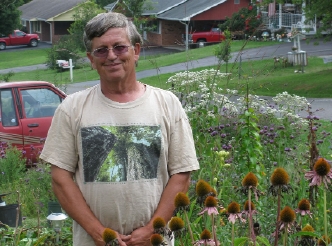
By Lisa Perry
The Southwest Times, Pulaski, VA, August
30, 2009
If you were to drive through a
neighborhood on the outskirts of Dublin off highway 11, you
might just happen upon an extraordinary garden. With the
exception of a few pathways, the entire yard, both in the front
and back of the property, is planted in daylilies, perennials,
wildflowers, and grasses. A number of them are unusual, rare or
endangered.
Larry Altizer grew up in and around
Radford. He comes from a long line of natives of this part of
the country. His family came to the area in 1752, and they have
been farmers here for eleven generations. Both sets of his
grandparents had farms, so he has many happy memories of
helping with the work there and of learning an appreciation and
love for plants from an early age.
He chose teaching as his profession, got
his masters degree from Virginia Tech in Blacksburg, and taught
math at Pulaski Middle School for twenty-six years. He then
taught at Cana over in Carroll County for five more. The hunger
for gardening never left him, though, and he retired from
teaching to start a landscaping company at his home in Dublin.
Although he is no longer landscaping, he continues to sell
plants from there and from the small daylily farm that he set
up near Fairlawn.
When he bought his house in 1978, he
planted mostly roses on the property. In 1983, he purchased a
few perennials, and that passion developed into a collection of
over three hundred varieties. In ’96 he bought a few
daylilies, then fifty more the following year and fifty more
the year after that. Now he has 350 varieties of lilies, many
which cannot be found anywhere else in this part of the state.
Larry’s lilies range in size and
form from hybrid daylilies to Asiatic, Oriental, Trumpet and
Orienpet varieties. The Orienpets are a cross between the
Oriental and Trumpet varieties. The Orientals are much larger
than the others and the stems grow much taller as well. They
tower over many of the other varieties that can also be found
blooming in his garden starting in the spring and lasting
through June and much of July.
Many of his perennials are wildflowers.
When asked where his passion for wildflowers originated, Larry
reflects back to his Grandmother Aker’s farm when he was
a boy. There was a field out near her vegetable garden behind
the house where he remembers spectacular displays of
wildflowers, especially in the fall. Joe Pyeweed, cardinal
flower, purple stem asters, ironweed, and boneset are some of
the ones he remembers from there so he has them in his garden
now. He also has penstemons, garden phlox, and the native
smooth phlox, numerous varieties of black-eyed Susan or
rudbeckia including Mexican redcap rudbeckia and Dumbo’s
ears rudbeckia. He has Echinacea, or coneflowers, Victor Jones
anemones, columbines, sedums, milkweed, skull cap, prairie
blazing star, Brazilian verbena, gaillardia, balloon flowers,
numerous varieties of asters, althea or rose of Sharon,
astilbes, rose turtle head, buddleia or butterfly bush, and
various mallows including hollyhocks. Among the flowers, he has
planted a variety of sizes and shapes of ornamental grasses
including bluestem, Indian, and zebra grasses.
Larry loves penstemons and he calls
himself a “penstemaniac.” He says that he started
giving away plants in’96 because he needed to divide them
to keep them healthy and also because he needed to make more
room for the new ones that he wanted to purchase next. Then in
’99 he started selling them at the Radford Farmer’s
Market downtown at Farmer’s Market Square. He jokes that
he needed to start selling them to support his overwhelming
habit and desire to purchase more.
He enjoys traveling the roads searching
for nurseries, gardens and arboretums. He has traveled to
various parts of the country including Pennsylvania, Florida,
Georgia and New Mexico looking for different and interesting
plants that he can bring back and acclimate to this part of the
country. He insists that that he will not use a greenhouse for
any of the plants he sells. That way, he knows they will be
able to adapt to the winters here and thrive in this climate.
Larry’s garden can be found at 6058
Dolphus Ave. in Dublin, and he is open by appointment. He can
be reached at 540-674-8251 or by emailing
daylilies6058@earthlink.net.
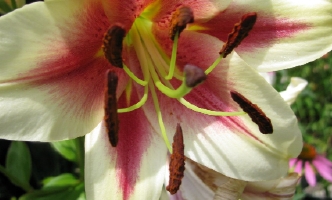
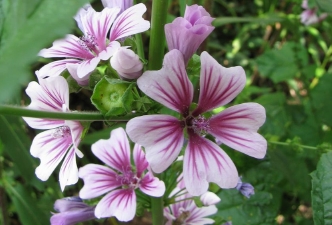
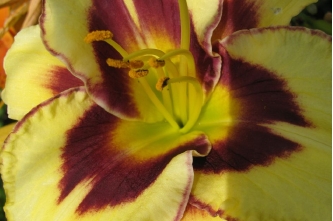
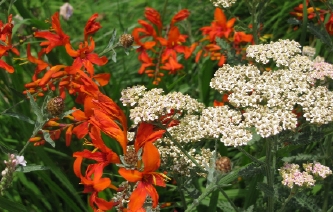
Windy Hill Stained Glass Studio
is Clator Lake Hideaway
By Lisa Perry
The Southwest Times, Pulaski, VA,
September, 2009
Driving around the countryside over by
Claytor Lake, you might be surprised when you come upon Windy
Hill Stained Glass Studio. It is a cute little shop that kind
of pops up out of nowhere on Lead Mine Road outside of
Hiwassee.
The building itself has quite a diverse
history. It was built in the 1960’s, and has been a
grocery store, a bar, an asphalt sales office, a landscape
office, a hamburger joint, and now a stained glass studio. It
started out as a grocery store that was part of the Wertz farm,
and they sold their produce there.
The farmhouse just up the hill above the
studio was built in the 1930’s and is part of the
original farm that includes sixty-seven acres. Cindy Schaeffer
and her husband Raymond bought the place about eighteen years
ago, and they have slowly but surely made improvements to the
property over those years. Raymond owns Built Right
Construction and so has the knowledge and talent for rebuilding
and repair. They have made some repairs on the barn and out
buildings, and they have built a lovely little green house,
complete with a piece of stained glass, and vegetable garden
space in the small valley behind the studio. They have some
cattle and are hoping to be able to have horses and more farm
animals as they continue their improvements.
The studio had to be gutted and rebuilt
from the inside. Now it has a space with lots of windows and
light in the front for displaying the stained glass, and a work
room in the back where Cindy crafts her pieces as well as
teaches classes in the art of stained glass construction.
She built a lovely flower garden in the front of the studio
with a picket fence and an artistically crafted walkway. It is
full of flowers in season. Cindy made a stained glass awning
for the front door, and designed the sign that hangs above it.
She took a class in stained glass work
twenty-one years ago, and has been “addicted to it”
ever since. She had done a wide variety of different types of
art before that, but something about working with glass clicked
for her. She says that the sewing, woodwork, gardening and
painting all came together out of her past to culminate in the
glass art. She loves the colors and textures and varieties of
shapes involved, and her pieces reflect that love and
perspective.
She started out using pre-designed
patterns from books, and her work became more complex and
intricate as time passed. She has a particular affinity for the
old patterns from the 20’s and 30’s because of
their delicacy and flowing qualities. She became known for that
old style after years of making pieces in that genre and she
still loves working with those. But over the years she
has developed her own style and designs. She found that many
people wanted to have glass art that reflected nature through
flowers, animals, trees, mountains and water, so she began to
develop her own creations with those themes. She added a
fanciful side to that style when she began developing designs
of mermaids and fairies. And she found a large group of clients
that wanted more contemporary pieces, so she developed that
style as well. Many of her pieces are one of a kind and
developed specifically for the clients involved.
When asked if she has a favorite piece,
she said that one of her original mermaid windows might hold
that distinction. It is a large half oval shape and very
colorful, with lots of the deep blue colors of water. She also
made a set of contemporary glass doors with accompanying panels
on each side that she loved doing.
She had a booth at the Roanoke City
Market for years where she not only sold the pieces that she
had already made, but she also developed a large clientele for
commissioned work. She has her glass in numerous doors and
windows of homes all over the area. She has done shows on
college and university campuses that resulted in commissions as
well. Radford College contracted her to restore some old
stained glass windows at Preston Hall that had been damaged.
When she completed the restoration, they were framed, staged
with back lighting, and hung in the executive boardroom there.
As her reputation has grown, the
commissions have kept her busy. Word of mouth has been one of
her best avenues for work. And she has done commissions for
people who have hired her husband to build their homes. Despite
the remote location of the studio, a number of people come and
go for the lake access and also from the boy scout camps in the
area, so that keeps a steady flow of people coming through her
doors.
Cindy also enjoys teaching other people
how to work with glass, so she conducts classes in the work
area of the studio. She has various classes based on skill
level starting with beginner, then intermediate, and finally
advanced. The classes are conducted one night a week for six
weeks. Each class lasts about an hour and a half. She has
people sign up, and then schedules the class when she has the
right number of students for that level. The beginner student
works on a panel of glass, the intermediate builds a panel
style lamp, and the advanced student constructs a tiffany lamp.
The work is detailed and meticulous and ranges from cutting and
grinding the glass to foiling and soldering and polishing it.
Cindy says that everyone finds at least some part of the
process that they enjoy, and everyone finishes with a piece of
stained glass that they have made and get to take home.
Besides her own work in the studio, she
also keeps a full range of supplies for stained glass artists.
She has the necessary tools, many pieces of glass, books on
pattern design and layout templates, various sizes of molds for
the lamps, and whatever else might be needed. She says that in
terms of stained glass supplies, if she doesn’t have what
is wanted, she can order it.
She also has some pottery by Jayn Avery
from Blue Heron Pottery in Floyd, and some jewelry made by
another Floyd artist. The studio is located at 3408 Lead Mine
Road not far from the Lighthouse Bridge and the phone number is
540-980-5481. She can also be reached at schaeffer_c@msn.com.
The shop is open all year on Fridays and Saturdays from 10 am
to 4 pm
